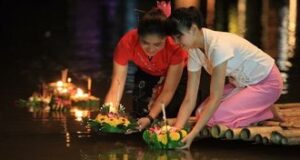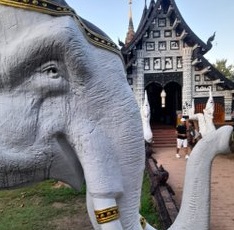Bhutan, often referred to as the “Land of the Thunder Dragon,” is a tiny kingdom nestled in the Himalayas, where ancient traditions and a deep sense of spirituality still thrive. The country offers a rare glimpse into a way of life that is intricately woven with Buddhism and nature. From its awe-inspiring mountains to its sacred temples, Bhutan’s culture remains remarkably intact, even as the world around it changes. In this article, we’ll explore Bhutan’s unique spiritual and cultural heritage, its vibrant traditions, and the challenges it faces as it navigates modernization.
The Beauty of Bhutan’s Landscape
Before diving into the spiritual and cultural aspects of Bhutan, one can’t ignore the breathtaking beauty of its landscape. Imagine flying into Paro International Airport, surrounded by towering, snow-capped mountains and lush, dense forests. The view from the airplane window is nothing short of a life-changing experience. It’s one of those rare moments when you feel simultaneously humbled and awe-struck by the sheer power of nature.
Journalist Stahl, who visited Bhutan, described it as “charming, absolutely charming.” She recalled the heart-racing descent as the plane made its way down steep mountain slopes. For anyone lucky enough to visit, Bhutan’s beauty isn’t just seen—it’s felt deeply, a sensation that resonates long after you’ve left.
Bhutan’s Deep Connection with Buddhism
At the heart of Bhutan’s identity is Buddhism. It is not just the state religion; it is the thread that ties the community together. Buddhism influences every aspect of life, from the way people interact with each other to how they approach life’s challenges. It’s not unusual to see people, young and old, walking past temples while spinning prayer wheels. These daily acts of devotion keep the spiritual fabric of Bhutan alive.
Buddhism is followed with devotion and passion in Bhutan.The teachings of the Buddha guide the country’s moral compass, influencing everything from policy to personal behavior. Most of the festivals, ceremonies, and even everyday activities are directly linked to Buddhist beliefs, making Bhutan one of the most spiritually unique places on Earth.
The Spiritual Importance of Prayer Wheels
One of the most fascinating traditions in Bhutan is the use of prayer wheels. These cylindrical devices, made from wood or metal, are inscribed with prayers and mantras. Spinning a prayer wheel is not just a mechanical action—it’s a deeply spiritual practice. It is believed that as you spin the wheel, you release positive energy into the world.
Dr. Lotay Tshering, Bhutan’s former prime minister, shared a powerful personal anecdote with Stahl. He explained that each prayer wheel is filled with millions of written prayers. The act of spinning the wheel while mentally reciting a wish for health, prosperity, or world peace is integral to the Bhutanese way of life. “Even now, I’m making my wish,” he said, as he spun a prayer wheel with Stahl.
The idea behind prayer wheels is simple yet profound: by engaging in this ritual, you are aligning yourself with the universe’s spiritual energy and sending your hopes into the world.
The Thimphu Drubchen Festival: A Living Tradition
One of the most spectacular displays of Bhutan’s spiritual devotion is the Thimphu Drubchen Festival, which has been held uninterrupted for over 400 years. The festival, celebrated annually in Bhutan’s capital, is a blend of colorful ceremonial dances, rituals, and prayers.
The festival is dedicated to female deities believed to offer protection and blessings. During the festival, masked dancers perform “Cham” dances, which are highly choreographed and rich in meaning. The masks and costumes represent various deities and spirits, and the dances are believed to bring blessings and protect the participants and the audience for the entire year.
For the Bhutanese, this festival isn’t just a cultural performance—it’s a sacred ritual. Even as the world modernizes, events like the Thimphu Drubchen hold the country’s ancient values close, offering both entertainment and divine protection.
Understanding Bhutanese Rituals and Blessings
Bhutan’s spiritual life is deeply intertwined with rituals that mark significant moments in people’s lives. Whether it’s a prayer, a dance, or a simple act like spinning a prayer wheel, these rituals help maintain the connection between the physical and spiritual worlds.
The Bhutanese believe that by witnessing sacred performances, such as the Cham dance or by taking part in ceremonies, they receive blessings that safeguard their well-being. This belief is so strong that many individuals plan their yearly activities around important religious dates, attending temples or ceremonies to receive the blessings they seek.
Traditional Archery in Bhutan
Bhutan’s traditions extend beyond spirituality into areas like sports and recreation, with archery being a prime example. Archery is not just a sport in Bhutan—it’s a cultural institution. The game is played with traditional bamboo bows and arrows, and the target is often set at a challenging distance of 145 meters, which is nearly the length of a football field.
The stakes in a traditional Bhutanese archery match are high. The first team to score 25 points wins the game, but the match can last for days, with teams engaging in friendly banter, song, and dance along the way. One of the most unique aspects of Bhutanese archery is the celebration after hitting the target. Just like in American football, teams often break into jubilant dances when they score, making the match as much about community celebration as it is about competition.
Also read: Bad Sisters Season 2: Anne-Marie Duff Teases Shocking Plot Twists
The Bhutanese Spirit: A Blend of Ancient and Modern
Despite the global tide of modernization, Bhutan remains deeply rooted in its traditions. Stahl observed that Bhutanese people continue to wear traditional clothes, live in ancient homes, and honor their heritage in ways that many other countries have abandoned. Bhutan’s resistance to Westernization helps preserve its cultural identity.
However, Bhutan faces an existential challenge: young people are increasingly leaving for better opportunities abroad, attracted by higher-paying jobs in places like Australia. This migration is slowly altering the country’s demographic makeup and could pose a threat to the preservation of its ancient traditions.
The Vision for the Future: Gelephu Mindfulness City
In response to the challenges of economic modernization, Bhutan’s King has proposed an ambitious solution: the Gelephu Mindfulness City. Located near the Indian border, the new city is designed to offer young people better job prospects without sacrificing the country’s cultural and spiritual identity.
The king envisions a city that blends modern infrastructure with Bhutanese values, where clean air, clean water, and Buddhism are central to the urban experience. The project, which includes sustainable architecture and a focus on spiritual well-being, aims to attract young Bhutanese back to their homeland.
The Role of Hydro-Power and Eco-Friendly Development
Bhutan is famous for its commitment to sustainability. The country generates most of its energy through hydroelectric power, making it one of the world’s most environmentally friendly nations. Hydropower projects are not only important for the country’s economy but are also intertwined with Bhutan’s values of clean living and respect for nature.
One of the most striking aspects of Bhutan’s future development plans is the integration of spirituality into this eco-friendly approach. A proposed hydroelectric dam, for example, will have a temple right in the middle of it—a symbol of the balance between progress and tradition.
Preserving Bhutan’s Spirituality in a Changing World
As Bhutan stands at the crossroads of modernization, it faces the difficult task of preserving its spiritual and cultural essence. Bhutan’s focus on Gross National Happiness (GNH) is a reflection of the country’s commitment to maintaining spiritual well-being even as it develops economically.
The world is watching to see how Bhutan will navigate this delicate balance. The nation’s example offers hope that it’s possible to embrace modernity while staying true to one’s spiritual roots.
How Bhutanese Architecture Reflects its Culture
Bhutan’s architecture is a testament to its rich history and Buddhist values. The country’s iconic Dzongs—fortress-like monasteries—are both administrative centers and sacred places of worship. Their majestic structures are designed to reflect the harmony between man and nature, spirituality and governance.
Even in modern projects like the Gelephu Mindfulness City, traditional architectural styles are being incorporated to maintain Bhutan’s aesthetic and spiritual legacy.
Bhutan’s Global Appeal: A Sustainable Model for the Future
Bhutan’s emphasis on sustainability and happiness makes it an intriguing model for the world. While many countries chase economic growth at the expense of the environment and well-being, Bhutan has found a way to prioritize both.
Bhutan’s focus on happiness over GDP, its commitment to preserving its culture, and its dedication to eco-friendly development are qualities that make the country an inspirational leader on the global stage.
Also read: 2025 Social Security Changes:One Move to Protect Your Future
Conclusion
Bhutan is a country where the ancient and the modern coexist harmoniously. It is a place where spiritual traditions are not just preserved but deeply woven into the fabric of daily life. As Bhutan faces the challenges of a changing world, it remains committed to preserving its unique identity while embracing a sustainable future. Bhutan’s story is a powerful reminder that true happiness comes not from material wealth, but from spiritual richness and a deep connection to the land and the people.
FAQs
What is the significance of prayer wheels in Bhutan?
Prayer wheels are sacred objects used in Bhutanese Buddhism. Spinning them releases prayers and positive energy into the world, helping to maintain spiritual balance and harmony.
What is the Thimphu Drubchen Festival?
The Thimphu Drubchen Festival is a centuries-old event that celebrates female deities and their protection. It features sacred Cham dances, which are performed to bring blessings and good fortune.
How does Bhutan maintain its traditional culture in a modern world?
Bhutan has actively resisted Westernization, ensuring that its cultural traditions, architecture, and way of life remain intact. The government encourages practices that honor the country’s Buddhist heritage.
What is the Gelephu Mindfulness City?
The Gelephu Mindfulness City is an ambitious urban development project in Bhutan designed to provide job opportunities for young people while maintaining Bhutanese cultural and spiritual values.
How does Bhutan incorporate sustainability into its development?
Bhutan generates most of its energy through hydroelectric power and prioritizes eco-friendly practices. Even modern development projects include sustainable designs that align with Bhutan’s commitment to clean living.


